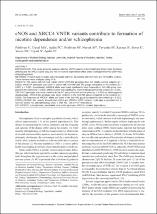| dc.contributor.author | Pehlivan, Sacide | |
| dc.contributor.author | Uysal, Mehmet Ali | |
| dc.contributor.author | Aydın, Pelin C. | |
| dc.contributor.author | Pehlivan, Mustafa | |
| dc.contributor.author | Nursal, Ayşe Feyda | |
| dc.contributor.author | Yavuzlar, Hazal | |
| dc.contributor.author | Kurnaz, Serdar | |
| dc.contributor.author | Sever, Ülgen | |
| dc.contributor.author | Yavuz, Ferhat K. | |
| dc.contributor.author | Uysal, Sezer | |
| dc.contributor.author | Aydın, Nazan | |
| dc.date.accessioned | 2019-05-10T09:38:48Z | |
| dc.date.available | 2019-05-10T09:38:48Z | |
| dc.date.issued | 2017 | |
| dc.identifier.citation | Pehlivan, S., Uysal, M.A., Aydin, P., Pehlivan, M., Nursal, A.F., Yavuzlar, H., Kurnaz, S., Sever, U., Yavuz, F., Uysal, S., & Aydin, N. (2017). eNOS and XRCC4 VNTR variants contribute to formation of nicotine dependence and/or schizophrenia. Bratislavske lekarske listy, 118 (8), 467-471 . | en_US |
| dc.identifier.issn | 0006-9248 | |
| dc.identifier.uri | https://doi.org/10.4149/BLL_2017_090 | |
| dc.identifier.uri | https://hdl.handle.net/11491/486 | |
| dc.description.abstract | BACKGROUND: This study aimed to evaluate whether VNTR variants in the Endothelial Nitric Oxide Synthase (eNOS) and the XRCC4 gene play any role in nicotine dependence (ND) and/or Schizophrenia+ND (Sch+ND) ethiopathogenesis. METHODS: Present study included 100 individuals with ND, 60 patients with Sch+ND, and 70 healthy controls. These variants were analyzed using PCR. RESULTS: The cases with ND had higher eNOS VNTR-BB genotype than the healthy control subjects (p = 0.001). eNOS-AA genotype was lower in cases with Sch+ND and ND groups compared to the controls (p = 0.001, p = 0.001, respectively). eNOS-B allele was found significantly more frequently in Sch+ND group compared to the controls (p = 0.001). eNOS-A allele was significantly lower in ND group than the controls (p = 0.001). XRCC4-ID genotype was more common in the ND group than the control group (p = 0.001) as heterozygosity disadvantage. XRCC4-DD genotype was more common in the Sch+ND group compared to the controls (p = 0.035). The frequency of XRCC4-I allele was lower in the Sch+ND group compared to the controls (p = 0.012). CONCLUSIONS: Our results showed that eNOS and XRCC4 VNTR variants might play a potential role in Sch+ND and/or ND pathophysiology. | en_US |
| dc.language.iso | eng | |
| dc.publisher | Comenius University | en_US |
| dc.relation.isversionof | 10.4149/BLL_2017_090 | en_US |
| dc.rights | info:eu-repo/semantics/openAccess | en_US |
| dc.subject | Endothelial Nitric Oxide Synthase | en_US |
| dc.subject | Nicotine Dependence | en_US |
| dc.subject | Schizophrenia | en_US |
| dc.subject | XRCC4 | en_US |
| dc.title | eNOS and XRCC4 VNTR variants contribute to formation of nicotine dependence and/or schizophrenia | en_US |
| dc.type | article | en_US |
| dc.relation.journal | Bratislava Medical Journal | en_US |
| dc.department | Hitit Üniversitesi, Tıp Fakültesi, Dahili Tıp Bilimleri Bölümü | en_US |
| dc.identifier.volume | 118 | en_US |
| dc.identifier.issue | 8 | en_US |
| dc.identifier.startpage | 467 | en_US |
| dc.identifier.endpage | 471 | en_US |
| dc.relation.publicationcategory | Makale - Uluslararası Hakemli Dergi - Kurum Öğretim Elemanı | en_US |


















